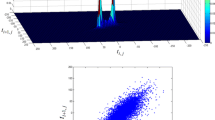Abstract
Small storage space for photographs in formal documents is increasingly necessary in today’s needs for huge amounts of data communication and storage. Traditional compression algorithms do not sufficiently utilize the distinctness of formal photographs. That is, the object is an image of the human head, and the background is in unicolor. Therefore, the compression is of low efficiency and the image after compression is still space-consuming. This paper presents an image compression algorithm based on object segmentation for practical high-efficiency applications. To achieve high coding efficiency, shape-adaptive discrete wavelet transforms are used to transformation arbitrarily shaped objects. The areas of the human head and its background are compressed separately to reduce the coding redundancy of the background. Two methods, lossless image contour coding based on differential chain, and modified set partitioning in hierarchical trees (SPIHT) algorithm of arbitrary shape, are discussed in detail. The results of experiments show that when bit per pixel (bpp)is equal to 0.078, peak signal-to-noise ratio (PSNR) of reconstructed photograph will exceed the standard of SPIHT by nearly 4dB.
Similar content being viewed by others
References
J. M. Shapiro. Embedded Image Coding Using Zerotrees of Wavelets Coefficients. IEEE Transactions on Signal Processing, vol. 41, no. 12, pp. 3445–3462, 1993.
A. Said, W. A. Pearlman. A New, Fast, and Efficient Image Codec Based on Set Partitioning in Hierarchical Trees. IEEE Transactions on Circuits and Systems for Video Technology, vol. 6, no. 3, pp. 243–250, 1996.
R. Koenen. Overview of the MPEG-4 Version 1 Standard, ISO/IEC JTC1/SC29/WG11 N1909, 1997.
T. Sikora. The MPEG-4 Video Standard Verification Model. IEEE Transactions on Circuits and Systems for Video Technology, vol. 7, no. 1, pp. 19–31, 1997.
ISO/IEC, ISO/IEC 15 444-1, Information technology-JPEG2000 Image Coding System, 2000.
M. D. Adams. The JPEG-2000 Still Image Compression Standard, ISO/IEC JTC1/SC29/WG1 N2412, 2001.
C. Christopoulos, A. Skodras, T. Ebrahimi. The JPEG2000 Still Image Coding System: An Overview. IEEE Transactions on Consumer Electronics, vol. 46, no. 4, pp. 1103–1127, 2000.
J. Li, J. S. Jin. Structure-related Perceptual Weighting: A Way to Improve Embedded Zerotree Wavelet Image Coding. Electronics Letters, vol. 33, no. 15, pp. 1305–1306, 1997.
S. Li, W. Li. Shape-adaptive Discrete Wavelet Transforms for Arbitrarily Shaped Visual Object Coding. IEEE Transactions on Circuits and Systems for Video Technology, vol. 10, no. 5, pp. 725–743, 2000.
W. K. Lin, N. Burgess. Low Memory Color Image Zerotree Coding. In Proceedings of Information, Decision and Control, IEEE Press, Adelaide, SA, Australia, pp. 91–95, 1999.
S. A. Martucci, I. Sodagar, T. Chiang, Y. Q. Zhang. A Zerotree Wavelet Video Coder. IEEE Transactions on Circuits and Systems for Video Technology, vol. 7, no. 1, pp. 109–118, 1997.
J. K. Rogers, P. C. Cosman. Wavelet Zerotree Image Compression with Packetization. IEEE Signal Processing Letters, vol. 5, no. 5, pp. 105–107, 1998.
S. H. Yang. Improved Embedded Zerotree Wavelet Coding of Images. In Proceedings of International Symposium on Multimedia Information Processing, Taipei, Taiwan, PRC, pp. 87–90, 1997.
Q. Wang, M. Ghanbari. Scalable Coding of Very High Resolution Video Using the Virtual Zerotree. IEEE Transactions on Circuits and Systems for Video Technology, vol. 7, no. 5, pp. 719–727, 1997.
J. H. Hu, R. S. Wang, Y. Wang. Compression of Personal Identification Pictures Using Vector Quantization with Facial Feature Correction. Optical Engineering, vol. 35, no. 1, pp. 198–203, 1996.
W. B. Pennebaker, J. L. Mitchell. JPEG Still Image Data Compression Standard, 1st Edition, World Press, New York, USA, 1993.
D. S. Taubman, M. W. Marcellin. JPEG2000: Image Compression Fundamentals, Standards and Practice, 1st Edition, Kluwer Press, Boston, USA, 2002.
J. C. Huang, Y. Wang. Compression of Color Facial Image Using Feature Correction Two Stages Vector Quantization. IEEE Transactions on Image Processing, vol. 8, no. 1, pp. 102–109, 1999.
S. Li, W. Li. Shaped-adaptive Discrete Wavelet Transforms for Arbitrary Shaped Visual Object Coding. IEEE Transactions on Circuits and Systems for Video Technology, vol. 10, no. 5, pp. 725–743, 2000.
K. H. Park, H. W. Park. Region-of-interest Coding Based on Set Partitioning in Hierarchical Trees. IEEE Transactions on Circuits and Systems for Video Technology, vol. 12, no. 2, pp. 106–113, 2002.
C. Y. Su, B. F. Wu. A Low Memory Zerotree Coding for Arbitrarily Shaped Objects. IEEE Transactions on Image Processing, vol. 12, no. 3, pp. 271–282, 2003.
C. H. Chuang, W. N. Lie. A Downstream Algorithm Based on Extended Gradient Vector Flow Field for Object Segmentation. IEEE Transactions on Image Processing, vol. 13, no. 10, pp. 1379–1392, 2004
Author information
Authors and Affiliations
Corresponding author
Additional information
This work was supported by National Natural Science Foundation of China (No. 60372066).
Li Zhu graduated from Huazhong University of Science and Technology (HUST), PRC, in 2000. He received the M. Sc. degree from HUST, PRC, in 2003. He is currently a Ph. D. candidate at Institute for Pattern Recognition and Artificial Intelligence, HUST.
His research interests include pattern recognition, digital image process, image compression, digital video coding, quality assessment, and computational vision.
Guo-You Wang received his B. Sc. and M. Sc. degrees in electronics and information engineering from the Huazhong University of Science and Technology, PRC, in 1988 and 1992, respectively. Currently, he is a professor in the Institute for Pattern Recognition and Artificial Intelligence at Huazhong University of Science and Technology (HUST), PRC. He received the Best Paper Award of National Natural Science Foundation of China in October 2007.
His research interests include artificial intelligence, image processing, robotics, and control theory.
Chen Wang received his B. Sc. and M. Sc. degrees in control science and engineering from Huazhong University of Science and Technology (HUST), PRC, in 2003 and 2006, respectively. He is currently a Ph. D. candidate at the School of Mechanical and Aerospace Engineering, Nanyang Technological University, Singapore.
His research interests include digital image processing and multimedia digital signal processing.
Rights and permissions
About this article
Cite this article
Zhu, L., Wang, GY. & Wang, C. Formal photograph compression algorithm based on object segmentation. Int. J. Autom. Comput. 5, 276–283 (2008). https://doi.org/10.1007/s11633-008-0276-8
Received:
Revised:
Published:
Issue Date:
DOI: https://doi.org/10.1007/s11633-008-0276-8




